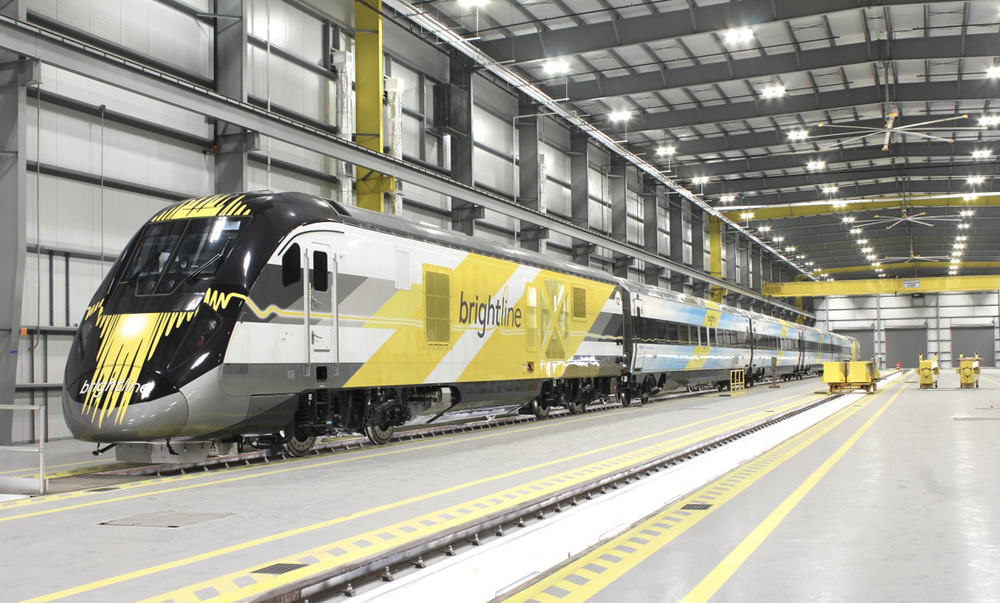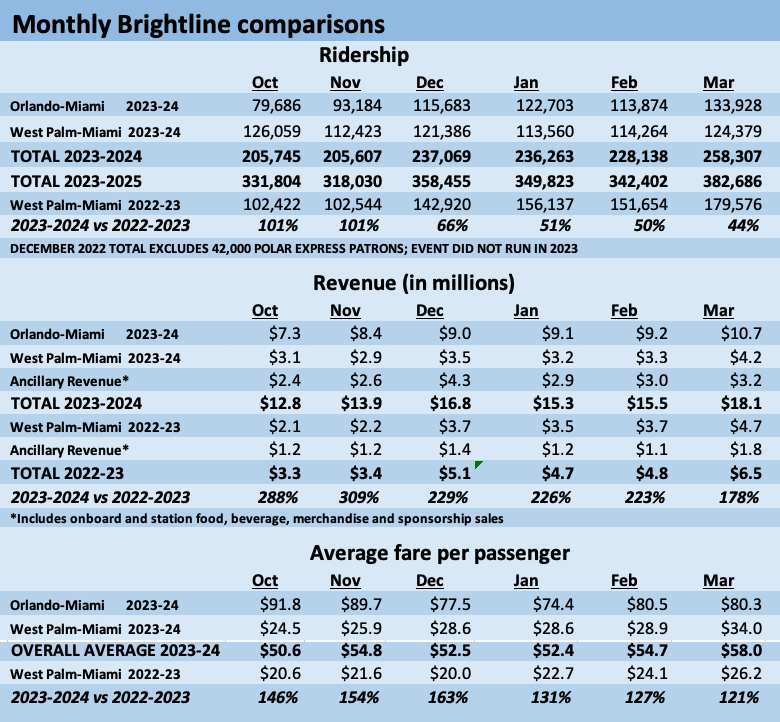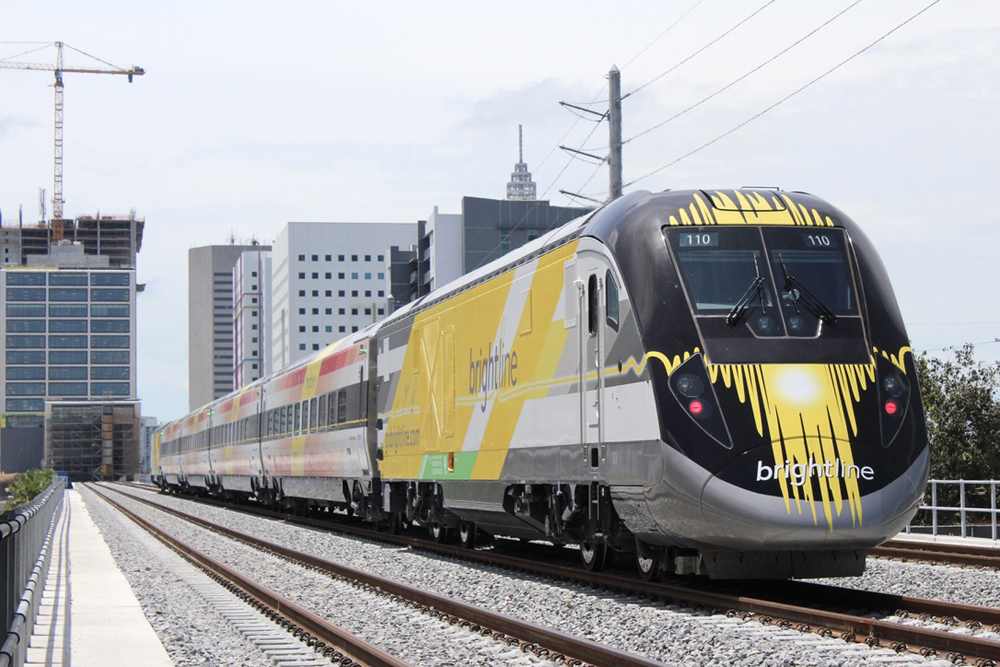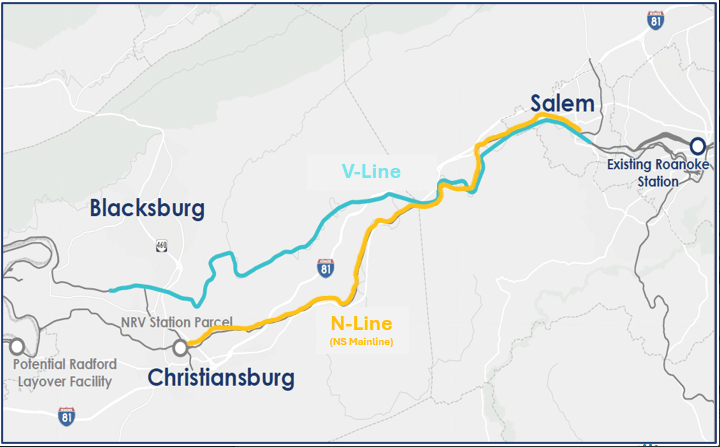
MIAMI — Commuters who have planned regular West Palm Beach-Miami travel around Brightline’s $399, 40-ride “SoFlo” monthly pass were informed last week that what amounts to the pass’s $10 per-ride fare will no longer be sold after May 31.
Available in its place will be 10-ride, 30-day passes. Prices for these will be $250 for Smart class and $350 for Premium between Miami and Aventura or Fort Lauderdale, and $350 Smart and $550 Premium between Miami and Boca Raton or West Palm Beach. For a rider who had been using the old pass to its full 40-ride maximum between Miami and West Palm Beach, the new equivalent in Smart class would be $1,400, or more than 3½ times as much.
Also discontinued May 31 is the 90-day, $1,199 “All-station Shared Pass” used by multiple travelers between any stop, but a “limited number” of $299 Aventura-MiamiCentral passes will remain “due to a prior agreement between Brightline and Miami-Dade County,” according to the Brightline website. A $95 monthly parking pass will also continue.
In order to encourage sampling and stimulate patronage, Brightline has introduced various pass programs since service south of West Palm began in 2018. Following a complete COVID-19 shutdown for over a year until November 2021, ridership grew rapidly as the average fare per passenger — including what passholders contributed — crept up.

The table above, incorporating March 2024 data released in the company’s $2.2 billion 2024 tax-exempt bond offering, shows that South Florida ridership grew by 75% from October 2022 to March 2023 while the per passenger fare average increased a little over 25%. Since Orlando-Miami service began on Sept. 22, 2023, overall metrics have reached all-time highs, fueled in recent months primarily by Orlando-South Florida growth.
Because all trainsets have three Smart coaches and one Premium class car, Brightline began limiting ticket sales to South Florida-only customers on high-demand departures [see “Brightline bond document revises forecast for 2024…,” News Wire, March 23, 2024]. While awaiting the 10 additional coaches on order from Siemens, the company has not attempted the logistically complicated manipulation of trainsets to add capacity on some frequencies while dropping cars from others.
To put demand pricing in perspective, a look at Smart fares quoted over the just-concluded weekend, for Monday, May 13, showed Miami-Orlando fares ranging from $39 (the last two trains of the day) to $164 for the 5:45 p.m. departure. To West Palm Beach, the range was $34 to $54, with that 5:45 p.m. train showing “sold out.” Trips on the lightly patronized trains to Orlando were priced only $5 more than a trip to West Palm Beach on the equipment’s previous or following trips.
Current passholders are being offered one complimentary 10-ride Smart pass to ease the transition, but many travelers who changed their commuting route to include Brightline told the Palm Beach Post that they would not pay the sharp increase.
Brightline has yet to respond to a News Wire request for comment on the changes to the pass program.
Brightline’s website does carry an advisory that the company has “worked with South Florida Regional Transportation Authority to facilitate a new Tri-Rail express route serving daily commuters between West Palm Beach, Boca Raton, Fort Lauderdale, and Brightline MiamiCentral Station. This plan was recently presented to the Tri-Rail Board and will be up for a vote in May.” Tri-Rail spokesman Victor Garcia told the Palm Beach Post the SFRTA board “is compiling passenger survey feedback before putting a proposed schedule together,” but it could take several months to implement if approved.

Tri-Rail began serving Brightline’s Miami terminal with shuttles and increased frequencies earlier this year [see “Tri-Rail increases MiamiCentral shuttles,” News Wire, Jan. 27, 2024.] Currently, there is a wide fare differential between the two parallel services from West Palm Beach, and each Tri-Rail train makes every stop. In the long term, there are plans for new commuter rail services on the Brightline route between Miami and Aventura, and connecting Aventura and Fort Lauderdale, but both are still years from operation. The Miami-Aventura project was recommended for more than $263 million in federal funds last year; documents accompanying that recommendation projected a 2027 start of service.














This is, let’s be honest, a s—show.
You cannot suddenly switch from being a commuter service to being an operator of vacation/business trip trains. That’s a surefire way of losing trust and making rail travel less attractive to everyone.
Worse, it’s not as if the commuter traffic and the one-off business trip/family Disney/Miami trip markets overlap that dramatically in terms of when people use them. 7-9am is peak travel time for people commuting. That’s more or less just before when most of those taking one-off trips start going. Yes, there’s some who’ll want to leave earlier, but it’s still the minority.
I know Brightline has been conservative with their equipment purchases, but they should have considered the possibility ridership rates would increase earlier than planned and had a contingency plan in place.
The feedback in several Miami publications on this change is 100% negative. Several people who actually moved to WPB and live in nearby condos to take advantage of the fares feel totally screwed.
The issue of WPB-MIA taking away capacity from ORL-MIA trains plus the issue of delays at the bridge in Stuart is making a near term operational and fare headache.
Say you are a customer originating in ORL and can’t book a seat because the seats are showing booked from WPB to MIA. That means the train runs empty from ORL. Not very profitable when those “full” booked seats came at a big discount.
Answer is to get more trainsets for the long (ORL) and intermediate (South of Stuart) stations, and Brightline has several trainsets on order from Siemens.
I believe they said that it was for redundancy. In the event one unit goes out, the other unit is online to use.
I’m curious. As between Amtrak, VIA Rail, and Brightline, it appears that only VIA Rail has bought Siemens cab cars. Why would Brightline need two locomotives for a four-car train? Seems to me the cab cars would be a slam-dunk. A locomotive at one end and a cab car at the other.
Thoughts anyone?
An interesting question. I wonder if it might have to do with horsepower requirements for the high speeds. I bet we have some experts out there in motive power!
Likely its a combination of higher-horse power for quick accelerations, including from station stops and speed restrictions to 90, 110, and 125 MPH; and redundancy in case of engine failure. These diesel trainsets are most like the HST ‘Intercity 125’ and they have two powercars/locomotives so as to reach and maintain 125 MPH, I read that one locomotive alone was able to keep the train running at 100 MPH, and the British Rail did see that as an imporant redundancy. As for the four-car train, well Brightline always has planned for longer consists, so they bought the locomotives they needed, but put of the trailer coaches, which seems a bit of a mistake as they are now apperently short on capacity, as their SoFlo ridership has done so well. If I was them, might consider running dedicated SoFlo sets, perhaps with just one loco and a cabcar, like Ontario Northland sets.
BJ and others — Thanks for the responses to my question.